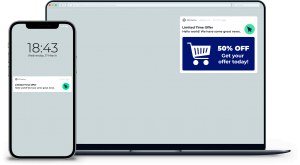Push Notification Ads: The Modern Approach to Targeted Advertising
Push Notification Ads: The Modern Approach to Targeted Advertising
Blog Article
Push notification ads have emerged as a powerful tool for businesses looking to engage users directly as well as in real time. These brief, attention-grabbing messages show on users' devices, often prompting immediate action. As consumers increasingly spend some time on mobile phones, push notifications offer advertisers a way to bypass crowded inboxes and social media marketing feeds, permitting them to deliver messages that reach users in the right moment.
While these ads may be highly effective, they also require careful planning to prevent becoming intrusive or unwelcome. Let’s explore the ins and outs of push traffic, their advantages, potential drawbacks, and finest practices.
What Are Push Notification Ads?
Push notification ads are short, clickable messages provided for users through mobile apps or web browsers. Unlike traditional ads, that happen to be passively seen on websites or social platforms, push notifications directly engage users by appearing on the screen—even after they aren’t while using the app or site that sent the content.
The notion of push notifications was basically introduced as a way for apps to transmit updates and alerts to users, including news, weather updates, or messages. However, the marketing potential on this direct-to-device communication quickly became evident, and advertisers began using them to promote products, services, or events.
Today, push notification ads are widely used to send personalized, timely content targeted at encouraging specific user actions, for example making a purchase, registering for an event, or downloading an app.
Advantages of Push Notification Ads
Instant and Direct Engagement: Push notifications appear upon the user's screen, providing a direct path to consumer engagement. Unlike emails or social ads that could be lost or ignored, push notifications prompt immediate attention.
Personalization: Using data from user preferences, location, and behavior, push notification ads may be highly personalized. Marketers can send specific messages tailored to individual users, like reminders on an abandoned cart or offers for nearby stores, increasing the chances of conversion.
Higher Open Rates: Compared to other digital advertising methods like email, push notifications have significantly higher open rates. Research suggests that users may interact with a notification on their own mobile device than select a link in the email or ad on a webpage.
Real-Time Communication: Push notification ads enable real-time marketing. Advertisers can instantly send notifications about limited-time offers, flash sales, or time-sensitive promotions, allowing users to act quickly and driving immediate results.
Cost-Effective: Since push notifications bypass traditional advertising channels, they could be a more cost-effective marketing strategy. There's no must pay for ad space or bidding on keywords; instead, push notifications reach a pre-existing audience.
Challenges of Push Notification Ads
Potential for Intrusiveness: Push notifications, if overused or irrelevant, can rapidly become annoying. Since they appear directly on a user's screen, they have the potential to disrupt day to day activities, leading users to disable notifications altogether or, worse, uninstall the app.
Opt-In Requirement: Unlike other kinds of advertising, push notifications require users to opt-in. Without user consent, businesses can’t send push notifications, limiting the opportunity audience. This places greater increased exposure of encouraging users to accept to receive notifications early in their relationship with the app or service.
Message Limitations: Push notifications are usually short, allowing only a little space for the advertiser to share a message. This brevity requires marketers being concise and clear, which may be challenging when trying to market complex offerings.
Risk of High Unsubscription Rates: If users obtain the notifications irrelevant or too frequent, they're able to easily unsubscribe from receiving future notifications. Once a user disables push notifications, it is difficult for the brand to reconnect with them through this channel.
Device and Browser Compatibility: Push notifications differ slightly across devices, operating systems, and browsers, which means marketers must make sure that their notifications are correctly optimized for every platform. Inconsistent delivery or formatting issues can harm user experience.
Best Practices for Push Notification Ads
Prioritize Relevance: The key to successful push notification ads lies in personalization. Notifications ought to be relevant to the consumer’s interests, behavior, and placement. Sending blanket notifications that aren’t personalized can result in higher opt-out rates and decreased user engagement.
Timing Matters: The timing of your push notification is important. Sending notifications at inconvenient times, such as late at night or during work hours, can frustrate users. Instead, send messages based on user habits and time zones to ensure maximum engagement.
Limit Frequency: Avoid bombarding users with too many notifications. Sending push notifications too frequently can cause users to disengage or unsubscribe. Instead, focus on sending fewer, more impactful notifications that provide real value.
Create a Clear Call to Action (CTA): Since push notifications are short and to the point, it’s important to include a clear call to action that directs the user on what to do next. Whether it’s “Shop Now,” “Claim Offer,” or “Learn More,” the CTA should be obvious and enticing.
Leverage A/B Testing: A/B testing allows marketers to experiment with different message formats, wording, and designs to see which notifications perform best. This data-driven approach ensures that businesses send optimized notifications that resonate using audience.
Offer Incentives: Providing users with incentives, like exclusive discounts or early entry to products, may make push notifications more inviting. These rewards can encourage users to engage with all the notifications as opposed to dismiss them.
Monitor and Analyze Performance: Like any online marketing strategy, it’s necessary to track the performance of push notification ads. Analyzing metrics for example click-through rates, conversions, and opt-outs helps identify which strategies will work and what areas need improvement.
Push notification ads present an innovative way for brands to talk directly with users in a very highly targeted and timely manner. When executed thoughtfully, they could significantly enhance user engagement, drive conversions, and boost brand awareness. However, businesses has to be mindful of frequency, relevance, and personalization to prevent the risk of alienating their audience.